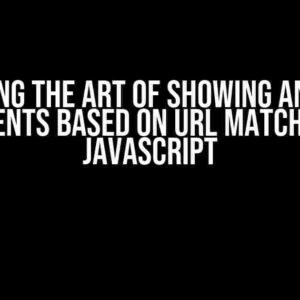Are you tired of scratching your head, wondering why the scrollIntoView method isn’t doing its job? You’re not alone! Many developers have fallen victim to the frustrations of this seemingly simple yet deceptively complex function. Fear not, dear reader, for we’re about to embark on a journey to diagnose and solve this problem once and for all.
Understanding scrollIntoView
scrollIntoView is a JavaScript method that allows you to programmatically scroll an element into view. It’s a straightforward concept: you pass an element as an argument, and the browser scrolls to that element. Simple, right? Well, not always.
The method takes an optional argument, behavior, which can be set to auto, instant, or smooth. This determines how the scrolling animation is performed. For our purposes, we’ll focus on the default behavior, which is auto.
Before we dive into the solution, let’s cover some common reasons why scrollIntoView might not be working as expected:
- Element not in the DOM: Make sure the element has been added to the DOM and is not dynamically generated or removed.
- Element not visible: Verify that the element is not hidden, and its parent elements are visible and not overflow:hidden.
-
Positioning issues: Avoid using
position: fixedorposition: absoluteon the element or its parents, as this can affect the scrolling behavior. -
Scrolling container issues: Ensure the scrolling container (e.g., the
<body>or a specific container element) is aware of the element’s presence and can scroll to it. -
Timing issues: Be cautious of timing-related issues, such as calling
scrollIntoViewtoo early or too late in the page’s lifecycle.
DEBUGGING TECHNIQUES
To tackle the issue, let’s employ some debugging techniques:
Method 1: Verify Element Existence and Visibility
Create a simple JavaScript snippet to check if the element exists and is visible:
const element = document.getElementById('myElement');
console.log(element); // Check if element exists
console.log(element.offsetParent); // Check if element is visible
If the element doesn’t exist or is not visible, revisit your code and ensure the element is properly added to the DOM and visible.
Method 2: Inspect the Scrolling Container
Investigate the scrolling container’s properties and behavior:
const container = document.querySelector('body'); // or a specific container element
console.log(container.scrollTop); // Check current scroll position
console.log(container.scrollHeight); // Check total scroll height
console.log(container.scrollHeight - container.scrollTop === container.offsetHeight); // Check if container can scroll
Verify that the scrolling container is capable of scrolling to the element and that the element is within its bounds.
Method 3: Check the Element’s Position and Offset
Use the getBoundingClientRect() method to inspect the element’s position and offset:
const element = document.getElementById('myElement');
const rect = element.getBoundingClientRect();
console.log(rect.top); // Element's top offset
console.log(rect.left); // Element's left offset
console.log(rect.width); // Element's width
console.log(rect.height); // Element's height
This helps you understand the element’s position within the scrolling container.
SOLUTIONS AND WORKAROUNDS
Now that we’ve debugged the issue, it’s time to implement solutions and workarounds:
Solution 1: Use scrollIntoView with an animation timeout
Sometimes, the browser needs a little extra time to process the scrolling animation. Try adding a short timeout:
const element = document.getElementById('myElement');
setTimeout(() => {
element.scrollIntoView();
}, 100); // Adjust the timeout value as needed
Solution 2: Use a library or polyfill
If you’re experiencing issues with older browsers or specific edge cases, consider using a library or polyfill like smooth-scroll or scroll-into-view.
Solution 3: Create a custom scrolling function
In some cases, you might need to create a custom scrolling function that takes into account the scrolling container’s properties and the element’s position:
function customScrollIntoView(element) {
const container = document.querySelector('body'); // or a specific container element
const rect = element.getBoundingClientRect();
const offsetTop = rect.top + container.scrollTop;
container.scrollTop = offsetTop;
}
Call this function instead of using the native scrollIntoView method.
CONCLUSION
And there you have it – a comprehensive guide to resolving the mysterious case of scrollIntoView not scrolling to the element. By understanding the common pitfalls, employing debugging techniques, and implementing solutions and workarounds, you should be able to overcome this obstacle and provide a seamless user experience.
| Common Pitfall | Solution |
|---|---|
| Element not in the DOM | Verify element existence and visibility |
| Element not visible | Check element and parent visibility |
| Positioning issues | Avoid using position: fixed or absolute |
| Scrolling container issues | Inspect scrolling container properties |
| Timing issues | Adjust timing of scrollIntoView call |
Remember, when dealing with scrollIntoView, patience and persistence are key. Take your time to debug and optimize, and your users will thank you for the smooth scrolling experience.
Bonus Tip
Don’t forget to test your implementation on different devices, browsers, and screen sizes to ensure compatibility and a seamless user experience.
Here are 5 Questions and Answers about “scrollIntoView is not scrolling to the element” in HTML format:
Frequently Asked Question
Get answers to the most common issues with scrollIntoView not working as expected!
Why is scrollIntoView not working when I call it on an element?
Make sure the element is visible and not hidden by another element or CSS styles. Also, check if the element is actually in the DOM and not dynamically generated after page load. If it’s still not working, try calling scrollIntoView on the parent element or a wrapping container!
I’m calling scrollIntoView on an element, but it’s not scrolling to the exact position?
Check if the element has any padding or margin that’s causing the offset. You can try setting the scrollIntoView options to `{behavior: “smooth”, block: “center”}` to get a more precise scroll. If that doesn’t work, try adjusting the element’s CSS to remove any extra spacing!
Is it possible to animate the scroll when using scrollIntoView?
Yes, you can! By setting the `behavior` option to `”smooth”`, you can enable a smooth animation when scrolling to the element. This will give a more pleasant user experience, especially for long scrolls!
How can I scroll to an element that’s inside a container with overflow: hidden?
You’ll need to call scrollIntoView on the container element instead of the inner element. This will ensure the container scrolls to the correct position, and then the inner element will be visible. Don’t forget to set the container’s `overflow-y` to `”auto”` or `”scroll”` for this to work!
Why is scrollIntoView not working in Internet Explorer?
Unfortunately, Internet Explorer (IE) has some limitations when it comes to scrollIntoView. You might need to use a polyfill or a fallback solution that uses JavaScript to manually scroll to the element. Yes, it’s a bit of a hassle, but it’s worth it for those IE users out there!
Let me know if you’d like me to make any changes!





